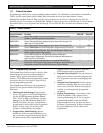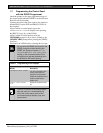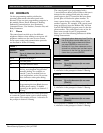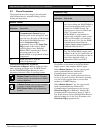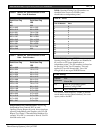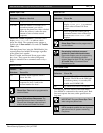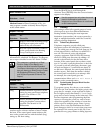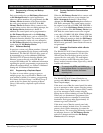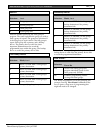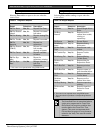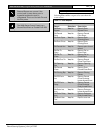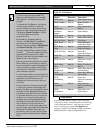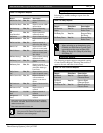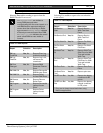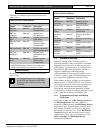
D9412G/D7412G | Program Entry Guide | 2.0 9000MAIN EN | 16
Bosch Security Systems | 1/04 | 47775E
2.3.3 Programming a Primary and Backup
Destination
Each route number has an
R# Primary Device
and
an
R# Backup Device
. In typical applications
where two phone numbers are programmed, the
R#
Primary Device
destination is the phone number
the route group attempts to dial first. If the
R#
Primary Device
destination fails to connect to the
central station receiver after two dialing attempts, the
R# Backup Device
destination is dialed. In
addition, the control panel can be programmed so
the
R# Primary Device
and/or the
R# Backup
Device
can be an SDI device, such as a D9133TTL-
E Network Interface Module. The control panel can
also be programmed to make only one attempt for
the
R# Primary Device
before attempting to send
events using the
R# Backup Device
.
2.3.4 Enhanced Routing
In previous versions, only Phone numbers 1 through
4 could be programmed for the Primary and Backup
Destinations. The D9412G/D7412G allow events to
be transmitted to up to four additional SDI Paths.
The D9133TTL-E Network Interface Module (with
Ethernet) connects directly to the SDI Bus and
occupies SDI Address 88. For additional information
regarding the specific programming requirements for
enhanced communications, see Sections 2.4 Enhanced
Routing and 6.5 Enhanced Communications.
2.3.5 Programming a Duplicate Report
To allow an event within a group to report to
multiple groups, the event should be Yes for each
route number available. For instance, programming
Fire Alarms for Route Group 1 and Route Group 2
results in the fire alarms first reporting to Route
Group 1 followed by a duplicate report to Route
Group 2.
2.3.6 Routing Destination Communication
Failures
When the
R# Primary Device
fails to connect with
the central station after one or two attempts (see
RG# 1 Attempt in
Sectio
n
6.6.1
Route Group
Attempts), the
R# Backup Device
phone number or
SDI Path is attempted. The central station receives
the original event with a COMM FAIL PHONE# =
(1, 2, 3, or 4) if the
R# Primary Device
destination
is a phone number. If the
R# Primary Device
is an
SDI Path, the central station receives the original
event with A COMM FAIL RG# SDI## (SDI Path
1 = 88, SDI Path 2 = 89, SDI Path 3 = 90, SDI Path
4 = 91). When all attempts to both the
R# Primary
Device
and
R# Backup Device
fail, a Comm Fail
RG# Event is generated. Comm Restore Events are
not generated.
2.3.7 Message Prioritization within a Route
Number
The D9412G/D7412G Control Panels meet the
digital reporting requirements for UL 864. Fire
Alarm Events have the highest priority and are
reported first for each group. The next highest
priority events are in the following order: panic,
duress, medical, intrusion alarm, supervisory, and all
troubles and restorals.
0101
0101
0101
To comply with NFPA and UL864, you
must program Route 1 to report only Fire
Alarm Events to ensure the fastest
reporting time.
2.3.8 Dialing Attempts
The D9412G/D7412G Control Panels have a
prompt called
RG# 1 Attempt
(see Section
6.6.1
Route Group Attempts.).
If this item is set to No, the control panel first makes
up to six attempts to make contact using the primary
device within a route group. If unsuccessful, it makes
up to four attempts to make contact using the
backup device before initiating a Comm Fail Report.
When only one destination is programmed, the
control panel makes ten attempts to contact that
destination. Each group takes approximately 10
minutes to go into Comm Fail.
If this item is set to Yes, the control panel only
makes one attempt (instead of two) to contact the
primary device before attempting to contact the
backup device. The route group still makes a total of
ten attempts; however, the
R# Primary Device
makes five attempts and then the
R# Backup
Device
makes five attempts.



